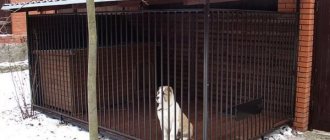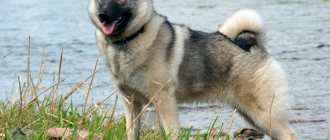Green stool
Stool acquires its green color due to the large secretion of bile or bile enzymes known as bilirubin and biliverdin. There may be several reasons for the appearance of such bowel movements:
- Inflammation of the gastrointestinal tract.
- Fungal infectious diseases, in which a fungal colony is able to multiply in the internal tissues and organs of the dog, disrupting their functions.
- Parasitic diseases caused by helminths, insect bites and other factors.
- Pathological abnormalities in the functioning of the liver and bile ducts.
- Cholelithiasis. The formation of stones in the gallbladder or bile ducts leads to stagnation of bile and is dangerous for the rupture of the gallbladder.
- External parasites. These include mites, scabies, lice-eaters and other blood-sucking representatives.
- Errors in diet planning. If the dog is prone to allergic reactions, manifestations of dysbacteriosis, or with an incorrectly selected diet, green stool can be a single symptom without causing pain in the animal. However, it is necessary to understand that a malfunction has occurred in the body’s functioning and, without treatment, the pet’s condition will significantly worsen.
Often, green stool is accompanied by a liquid consistency, which may be an indicator of a putrefactive process in the dog’s intestines. This is an alarming and dangerous symptom of a disease that poses a threat to the pet’s life.
Manifestation of diarrhea
To independently determine why your dog has loose stools, you need to pay attention to the following signs:
- feces have changed their density, that is, they have become liquid;
- a very pungent and unpleasant odor appeared;
- blood began to appear in the feces;
- During defecation, the animal experiences severe pain.
At the same time, pets often begin to behave very nervously. Dogs whine and stop eating as usual, which is why they lose weight very quickly. Very often diarrhea is accompanied by vomiting. In this case, the dog may lose control of bowel movements.
White stool
The white color of feces, first of all, indicates tumor formations in the liver, gall bladder or digestive organs. Such excrement may indicate the following disorders in the body:
- Malignant tumors of the liver or gallbladder disrupt the normal flow of bile.
- Inflammation of the pancreas (pancreatitis).
- Inflammation of the liver and bile ducts (cholangiohepatitis, cholangitis).
- Inflammatory process in the liver (infectious and toxic hepatitis).
- Liver failure with threat of liver cirrhosis.
- The formation of cystic nodes in the liver and disruption of the functions of this important organ.
- Changes in the gallbladder - its deformation, reduction in size.
- Excessive consumption of foods with high fat content (pork, sour cream) or other unusual foods. In the absence of other symptoms (vomiting, abdominal pain, apathy), it is allowed to monitor the dog’s stool for one day before going to the clinic, provided that the owner is sure that the origin of the white feces is due to an error in the diet.
Treatment of yellow diarrhea in dogs, what to do, how to treat diarrhea?
The most unfortunate outcome of diarrhea is death from dehydration. Therefore, if you find your pet has loose stools, you must immediately provide him with a source of replenishing water reserves in the body and take emergency measures to stop diarrhea and vomiting. If the dog cannot or does not want to drink on its own, you need to inject water into its mouth using a syringe. To maintain the proper level of water-salt balance, your four-legged friend can be given Regidron solution, activated carbon tablets, Smecta and No-shpu or Papaverine.
During the first day of illness, you should stop all meals and replace them with plenty of fluids. Full treatment for diarrhea can only begin after diagnosis by a qualified doctor. If diarrhea is prolonged, probiotics and vitamins are added to the list of medications indicated for the patient to maintain the balance of intestinal microflora. If treatment is carried out at home, it can be supplemented with alternative medicine.
Black stool
The black color of the stool indicates the presence of blood in it. If the bright red color of the blood indicates the formation of bleeding in the large intestine or in the anal area, then the dark color of the discharge indicates that it has been processed by enzymes and the cause of its occurrence is located in the digestive tract or small intestine.
So, black feces may indicate the presence of serious problems in the pet’s health:
- Presence of helminths. By parasitizing the intestinal mucosa and destroying it, helminths gain access to the dog’s blood. Some of the blood enters the intestines, from where it is excreted.
- Infectious diseases – parvovirus enteritis. If you are infected with a dangerous infection, you need to know that blood discharge does not come out as a homogeneous mass with the dog’s stool, but is contained in small clots.
- Stomach ulcer. This dangerous disease is associated with internal gastrointestinal bleeding, which explains the appearance of dark discharge in the dog's stool.
- Hemorrhagic gastroenteritis occurs as a result of inflammation of the stomach and intestines. Complications from infectious diseases, stressful situations (for example, during medical therapy), circulatory disorders - all these are the causes of this dangerous disease.
- Damage to the walls of the gastrointestinal tract by a foreign object. It is dangerous if your pet swallows a hard and sharp object, which can cause tissue damage and cause internal bleeding.
The appearance of loose black stool indicates extensive internal bleeding and is extremely dangerous for the pet’s life.
Blood in dog stool - causes
Blood in a dog's feces should be considered a dangerous pathology. This is a reason for a detailed examination. It is important to identify the cause and establish the location of the source where the blood is coming from. We are talking about the gastrointestinal tract or nearby areas. Blood impurity means that the bleeding is localized in the gastrointestinal tract.
If the blood has been affected by enzymes, it will be scarlet. It will also remain the same if the bleeding is localized in the distal region - the rectum, the area of the large intestine. It will be more difficult to detect it if the enzymes still “caught up”. In this case, it will look like coffee grounds. This is a situation where the active focus is in the esophagus and stomach.
Blood in a dog’s stool is a reason for a detailed examination
The structure of stool and the amount of blood in it indicates the following diseases:
- Parvovirus enteritis . It most often affects young dogs or puppies. The virus enters the animal through the nose when the pet sniffs someone else's feces and food. With this disease, one of the symptoms will be bloody stool;
- Hemorrhagic gastroenteritis . There are many reasons for the development of this disease. But its main symptom is severe diarrhea, when the masses become red due to a large amount of blood. The disease is such that until blood “inserts” appear, other signs may not come out;
- Substances . Bloody diarrhea can be caused by medications and chemicals. For example, coumarin, which is included in the drug for mice. When sniffing this remedy, the next day the animal may begin to walk around with a lot of blood;
- Plague . The disease is fatal. Accompanied by diarrhea with scarlet or maroon blood. Other symptoms are convulsions, trembling, vomiting, lethargy.
In addition to the above pathologies, traces of blood can also be observed in diseases such as ulcers, colitis, adenocarcinoma, Addison's disease, helminthiases, bruises, hemorrhoids, allergies. There are many reasons for the occurrence of non-standard feces, so if there is a deviation from the norm, it is necessary to carry out a competent diagnosis.
Video - Dog poops blood
Yellow stool
The yellow color of an animal's stool can indicate either a problematic health condition or be the result of consuming foods containing carotene.
Yellow feces are characteristic of such abnormalities as:
- Liver dysfunction (cirrhosis, hepatitis, neoplasia). A yellowish tint to feces appears when the liver malfunctions; it is intermediate and characterizes the transition to lightening of feces to a white color.
- Presence of helminths. The color may be yellowish due to the presence of worms and their larvae in the feces.
- Malfunction of the pancreas. Due to disturbances in the production of hormones, the body cannot cope with the processing of fats and feces acquire an oily sheen and a yellow color.
- Eating foods containing carotene (carrots, cereals, etc.). The animal’s body does not digest carotene and excretes it intact.
Reasons for the formation of yellow loose stools:
- intestinal infections;
- infection with a viral infection, for example salmonellosis, parvovirus;
- incorrect diet.
why does my puppy have soft stools?
Mucus in the feces and loose stools in a puppy
Puppy, girl, age 2 months. We fed him dry food Pro Plan (soaked before feeding), morning feeding - low-fat cottage cheese and a little kefir at night. Boiled meat was also sometimes given. 4 days ago, mucus suddenly appeared in the thick stool, quite a lot. Then several times she squirted almost nothing but mucus. Then, towards evening, normal stools again. The diet did not change on this day. The next morning there was normal stool, but then about an hour later there was stool with mucus again. They called a doctor, she said there was an error in the diet, apparently, I needed to switch to boiled rice. We switched to rice, the stool turned yellow, became even softer, and smelled sour. like breastfed babies.
The next morning, the food was again, the cottage cheese and kefir were removed, the feces were formed, but very soft, leaving a watery spot on the diaper. And I started pooping more often, one large portion in the morning, and then every now and then a little mushy stool.
This morning the first portion of stool was voluminous, sausage-like, but soft. Then I sat down 3 times and squeezed it out drop by drop. And the third time it was actually a drop of pink mucus - pink due to the presence of blood, apparently.
Doctor's recommendation - medicinal food (dry), chamomile decoction, Vitom 1.1, About Colin, Smecta, Ersefuril.. Treatment started yesterday (except for Ersefuril, although it is probably necessary), there is no result yet, or rather, pink mucus has appeared.
In general, the puppy’s health is good - he plays, eats with appetite, gains weight (now about 8 kg), his nose is wet and cold. But here's a chair.
Today I have already squatted down three times and squeezed out drops of mucus streaked with blood. And the last stool for today was much looser than yesterday. Could this be a reaction to chamomile or Procoline? Is Smecta needed now? Or replace it with Enterosgel? Or at all
Source
Signs of pathology
A sensitive attitude towards your pet helps to avoid many canine ailments. If, along with dark stools, the dog has changed its behavior, has become apathetic, its eyes become sour, suffers from flatulence, and vomiting appears, contact a specialist.
The following pathologies are accompanied by black feces.
Gastric volvulus
Responsible breeders monitor the diet of their shaggy friends. Animals must eat three times a day. High-quality products and the right amount are easy to digest - dogs do not develop stomach illnesses.
But rare feeding in large portions, long active games immediately after meals, stress sometimes lead to volvulus of the stomach (intestines). At this moment, one of its sections is twisted, and blood flow in it is disrupted. Tissue necrosis begins. The dead part of the intestines provokes blood poisoning.
Important! When your stomach turns upside down, the minutes count. If the dog is not taken to the clinic within two hours, death is inevitable.
You can notice signs of trouble by the following symptoms:
- The dog cannot go to the toilet when absolutely necessary.
- Her stomach is swollen, she whines and nuzzles him.
- The animal does not eat or drink.
- The dog suffers from nausea and vomiting.
Such animals are saved by surgery. The main thing is not to get confused and call for help in time.
Oncological diseases
Stomach cancer, which is accompanied by black liquid feces in dogs, is not a common occurrence. This is the karma of large dogs: collies, terriers, shepherds, bull terriers. Older individuals, more often males, become ill.
Important! Veterinarians do not name the exact cause of the disease. They think it's stress, unhealthy diet, toxins, radiation.
The onset of the disease occurs without specific symptoms. The animal moves less and eats poorly. Owners are alarmed by weight loss, vomiting, belching, and gases with the smell of a rotten egg.
A malignant tumor is diagnosed in the clinic. Treatment often leads to positive results.
Oncological diseases need to be detected early
Manifestation of diarrhea
Indigestion is caused by spoiled foods, helminths, food allergies, gastritis, infections and poisoning, and overeating. The stool becomes liquid and dark in color.
Diarrhea for several hours or one day is normal. The dog is fed less and given a lot of water. But if the condition drags on for several days, the patient is taken to the doctor. The specialist identifies the cause and prescribes treatment. Advice from fellow dog breeders can lead to serious consequences.
Important! Diarrhea is dangerous due to dehydration and metabolic disorders.
Hemorrhoidal bleeding
The dog has prolonged constipation, hard feces with blood, itching and redness around the anus. She tries to reduce discomfort by crawling on the floor on her butt and often licking the anus.
All signs indicate that the pet has hemorrhoids - the hemorrhoidal veins have dilated, and blood has stagnated in them. This ends with the protrusion of the nodes from the anus, or they are localized in the rectum.
Hemorrhoids in a dog
They treat with enemas, suppositories, soft nutrition. The disease is usually easy to treat.
Infectious, toxic gastroenteritis
The causes of the disease are viruses, intoxication, bacteria. The disease is accompanied by striking symptoms: black loose stools, weakness, intestinal colic. The body temperature rises, the pet begins to drool, and the heartbeat quickens. Paws, nose and ears become cold, vomiting bile and blood.
Treatment begins with fasting. The dog is given only a drink, then boiled rice in small portions. The veterinarian prescribes strengthening agents and antibiotics.
Enterocolitis
Acute and chronic forms occur against the background of inflammation in the large and small intestines. The influence is caused by infections and poisoning, an indigestible object in the stomach.
Symptoms:
- fever;
- thin black stool;
- bloating, nausea.
In the chronic course of the disease, the dog loses weight, crawls on the floor, and licks the anus.
Complex treatment includes diet, gastric lavage, and IV drips to restore water balance. Medicines include a course of antibiotics, dewormers, and anti-inflammatory drugs.
Prevention
To prevent your animal from getting sick again, you must adhere to the following recommendations:
- Under no circumstances should you feed your dog from the table. For four-legged pets, the food their owner eats is very harmful.
- It is recommended to visit a doctor who will develop a special diet for your pet.
- Under no circumstances should you overfeed an animal. The fact is that the intestines of dogs tend to stretch, which is why it loses its functions.
- Periodically it is necessary to treat the animal against parasites. Do not forget about the mandatory vaccination for dogs, which is carried out in veterinary clinics.
- Do not allow your pet to pick up any objects or food from the ground.
If the owner notices even the slightest discomfort in his pet, then he needs to consult a specialist as soon as possible.
As already mentioned, rare breeds of dogs suffer from such ailments much more often. Therefore, you need to select a diet based on the characteristics of the animal.
To prevent your husky from suffering from such ailments, you need to feed her immediately after she comes from a walk. Moreover, the amount of food directly depends on how old the pet is, as well as on the conditions in which it lives.
A huge amount of specialized dry food has been developed for this breed, which can form the main diet of the animal. You can also give him canned food and some types of natural food.
It is worth considering that this breed of dog has a rather poor appetite. At the same time, they have a very sensitive gastric system. Therefore, the composition of the food must be developed for these dogs on an individual basis. Shar-Peis should never be overfed, as they may become less active, and as a result, the pet will develop kidney disease.
Diarrhea in these dogs very often begins due to an allergic reaction. This is due to food sensitivities. Therefore, you should not change food too often; it is better to choose a specific menu with a specialist and stick to it. In addition, Shar Peis should never be given liquid food (for example, broth). You need to make sure that the food is thick and dry, so it is best to feed the animal dry food.
This breed of dog also has its own specific characteristics. Very often these pets develop parasites in their ears. Because of this, an infectious disease may develop, which, in turn, will lead to diarrhea. Therefore, it is necessary to clean your pet’s ears as often as possible.
If we talk about diet, then it is necessary to calculate the norm for each meal. The fact is that these animals spend a lot of energy and constantly want to eat, but under no circumstances should they be overfed. It is recommended to feed Labradors natural meat, but vegetables and cereals should be given to them as rarely as possible. Pasta products are also contraindicated for these animals.
Smaller representatives of rare breeds need increased attention. It is important to consider the reasons why your dog has loose stools. We described what to do in this situation in the article.
If the owner notices even the slightest discomfort in his pet, then he needs to consult a specialist as soon as possible.
Features of animal nutrition with diarrhea
If an animal does not want to eat on its own, then you should not force feed it. However, when a pet refuses water, it is necessary to take any measures, but force him to drink the liquid. To do this, you can purchase the largest syringe at the pharmacy, remove the needle, pour water into it and thus give your pet water.
When the dog feels better, you can introduce low-fat foods into the diet, for example, boiled eggs, chicken or fish. However, during the first 3 days, the dog must be given rice water.









